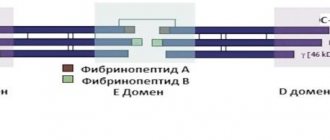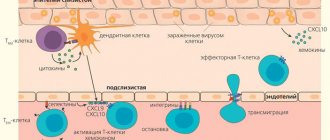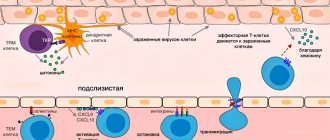Stroke
30182 11 August
IMPORTANT!
The information in this section cannot be used for self-diagnosis and self-treatment.
In case of pain or other exacerbation of the disease, diagnostic tests should be prescribed only by the attending physician. To make a diagnosis and properly prescribe treatment, you should contact your doctor. We remind you that independent interpretation of the results is unacceptable; the information below is for reference only.
Coagulogram (screening): indications for use, rules for preparing for the test, interpretation of the results and normal indicators.
Content
- Blood clotting process
- Prothrombin time indicators
- Determination of prothrombin time according to Quick
- Methodology for studying prothrombin time
- Indications for prescribing prothrombin time analysis
- Prothrombin time indicators during pregnancy
The coagulation and anticoagulation systems of the blood determine the continuous flow of blood in the vessels, thereby ensuring all the vital functions of the body.
The anticoagulant system keeps the blood fluid, while the coagulation system prevents possible bleeding by forming blood clots.
Prothrombin index during pregnancy
A hemostasiogram (coagulogram) during pregnancy is mandatory, since the prothrombin index of a pregnant woman is an important indicator that makes it possible to prevent severe bleeding during childbirth or prevent the formation of blood clots.
If a woman’s prothrombin index is reduced (less than 80%), then there is a risk of bleeding, and it makes sense to prescribe coagulants to the patient. If the prothrombin index is elevated, that is, it is about 100%, the pregnant woman is prescribed drugs that prevent increased blood clotting.
An important indicator for a pregnant woman is the prothrombin time. A doctor who knows the clotting time of a woman in labor can prevent bleeding or, if it does begin, the development of hemolytic shock, which in most cases is the cause of death of a woman during childbirth.
Pregnant women have different attitudes towards the need to register with an antenatal clinic. Some people follow all the doctor’s recommendations, while others believe that a large number of tests only harms their health and family budget.
The main thing that a pregnant woman should remember is that if the doctor does not know that her prothrombin index is low, he will not be able to prevent placental abruption or bleeding after childbirth, and vice versa, a high prothrombin index will be able to promptly indicate to the doctor the danger of developing placental vascular thrombosis.
Blood clotting process
If we briefly describe the coagulation process, it will consist of the following phases:
- prephase or vascular-platelet hemostasis;
- prothrombinase;
- thrombin;
- fibrin;
- postphase, which consists of two parallel processes: retraction (reduction and thickening of the blood clot) and fibrinolysis (dissolution of the blood clot).
Thus, for the formation of a blood clot, several components are necessary: the vessel wall, blood elements, and the plasma blood coagulation system.
This process looks like this: damage to the vascular endothelium causes activation of enzymes of the coagulation system, which, in turn, forms fibrin threads, which are the framework for the formation of a blood clot.
The coagulation system is activated in two ways:
1. External - when coagulation factors come into contact with damaged tissues outside the vessel.
2. Internal - associated with destroyed blood cells and damage to the endothelium, that is, the process starts inside the vessel itself.
What is important to know about registering for tests
Do I need to make an appointment: It is better to make an appointment for blood tests and smears to avoid waiting in the treatment room.
Opening hours of the treatment room: Mon - Fri from 8:00 to 12:00
Form of payment: cash, credit cards
Doctor's referral: not required
Minimum patient age: Urinalysis, stool test - any age, blood test - from 10 years
How quickly the results are ready: Average time 1-2 business days. Ready results can be received by email or during a second visit to the clinic
Prothrombin time indicators
Prothrombin time is a special laboratory indicator that reflects the external pathway of activation of the blood coagulation system.
Often, prothrombin time is determined with activated partial thromboplastin time (aPTT), which evaluates the intrinsic activation pathway. Taken together, these two indicators reflect the coagulation and anticoagulation systems as a whole and its changes in the pathology of internal organs.
The normal prothrombin time is 11-16 seconds.
Also, to determine the functions of the coagulation system, other indicators are determined - prothrombin index and international normalized ratio (INR).
Prothrombin index (PTI) is a percentage indicator determined by the ratio of the prothrombin time of control plasma to the PTI of the test human plasma. Normally it should be 95-105%.
International Normalized Ratio (INR) – This test compares blood taken from a patient to internationally normalized plasma.
The norm value can range from 0.85-1.25.
It should be borne in mind that during warfarin therapy, indicators may change, so it is necessary to take into account medical history.
Price of a blood test for prothrombin
| Service | Price |
| Prothrombin (according to Quick) + INR | 250 rub. |
| APTT | 190 rub. |
| Thrombin time | 200 rub. |
| Fibrinogen | 190 rub. |
| Antithrombin III | 350 rub. |
| D-dimer | 1100 rub. |
| Protein S | 1700 rub. |
| Protein C Lupus anticoagulant | 1320 rub. |
Methodology for studying prothrombin time
To determine the prothrombin time, fresh plasma from the patient being studied is used. The blood is collected in a tube containing sodium citrate to bind blood calcium. Next, the sample is mixed, centrifuged, and an excess amount of calcium is added at a temperature of 37C to restore the blood’s ability to clot. After this, tissue coagulation factor (better known as factor III) is added and the time of blood clot formation is noted.
It should be taken into account that in some pathologies the prothrombin time may be increased or decreased.
Prothrombin time is increased with:
1. Congenital deficiency of certain blood coagulation factors such as II (prothrombin), V (Proaccelerin), VII (Proconvertin), X (Stewart-Prower factor).
2. Acquired deficiency of blood coagulation factors resulting from diseases (chronic liver and kidney diseases, amyloidosis, autoimmune diseases).
3. Disseminated intravascular coagulation syndrome (DIC syndrome), which develops in blood diseases, including cancer.
4. The use of indirect anticoagulants (warfarin) in the main therapy.
5. Developmental hypovitaminosis K (for diseases of the pancreas and gall bladder, dysbacteriosis, malassorption syndrome).
6. An increase in the level of antithrombin in the blood.
The use of certain drugs also leads to an increase in prothrombin time (some antibiotics, steroid hormones, laxatives, acetylsalicylic acid in doses exceeding therapeutic ones).
Prothrombin time is reduced with:
1. Polycythemia.
2. Pregnancy in the last trimester.
3. Thrombosis of deep veins of the lower extremities.
4. Use of acetylsalicylic acid in small doses.
5. Taking oral contraceptives.
Where to take a prothrombin test in St. Petersburg?
You can get tested for antibodies to prothrombin in St. Petersburg at our MRI center and RIORIT clinic. You can make an appointment and find out the cost of the examination by phone..
MRI and ultrasound center RIORIT
Area:
Kalininsky
Metro:
metro station Grazhdansky Prospekt, metro station Devyatkino, metro station Prospekt Prosveshcheniya
Address:
St. Petersburg, Kalininsky district, st. Rustaveli, 66 lit. G
Telephone:
Equipment:
Siemens, open type
Schedule:
Around the clock
Indications for prescribing prothrombin time analysis
- detailed examination of the whole body;
- pre- and postoperative examination;
- suspicion of impaired hemostasis;
- suspicion of hidden bleeding;
- suspicion or presence of thrombosis;
- control of hemostasis functions during treatment with direct and indirect anticoagulants;
- diagnosis of liver diseases;
- a history of cardiovascular diseases and their complications, as well as thromboembolism of various organs;
- diagnosis of nosebleeds and hemorrhages in various organs and tissues;
- diagnosis of chronic anemia.
Preparing for a blood test for prothrombin time:
- do not eat 12 hours before taking a blood test;
- do not smoke 30-60 minutes before the test;
- limit physical and psycho-emotional stress;
- if possible, discontinue medications that affect coagulation or prescribe a study before starting therapy;
- follow a diet excluding fried and very fatty foods.
Preparation for the procedure
The essence of a coagulogram is to assess the activity of proteins of the blood coagulation system.
Therefore, proper preparation for this analysis is extremely important. Blood is taken on an empty stomach; the last meal should be at least 8-10 hours before the test. It is recommended to exclude excess amounts of fatty, sweet and protein foods. The drinking regime remains normal. The day before it is necessary to avoid stressful loads and intense sports. If the patient is taking any medications that affect coagulogram parameters, then, depending on the goals set for the study, it is necessary to either continue or stop taking them a few days before. This should be discussed with your doctor before taking the test.
If you need urgent results, you can contact the INVITRO offices, where express diagnostics are carried out. In this case, the analysis will be ready in about 2 hours.
Some of the proteins of the blood coagulation system are acute phase proteins. They are produced during stress, which includes not only physical and emotional stress, but also illness. Consequently, any persistent or short-term, but intense stress in the body can lead to changes in coagulogram parameters.
Dehydration (dehydration) is one of the reasons for blood thickening and an increase in the concentration of coagulation factors, which also leads to a distortion of the result.
The state of the blood coagulation system changes during pregnancy, both in the direction of increasing and decreasing the activity of a number of proteins.
The use of many medications affects the blood coagulation system. Thus, the first generations of oral contraceptives lead to an increased risk of thrombosis, and anticoagulants lead to bleeding. The list of drugs that affect the activity of the coagulation system is huge. When receiving any drug therapy, you should first consult with your doctor about the possible effect of a particular drug on the test result.
Taking certain medications by a pregnant woman, for example, warfarin, rifampicin, phenytoin, barbiturates, affects the production of clotting factors in the fetus. The child may subsequently be at high risk of bleeding.
Prothrombin according to Quick is reduced
Prothrombin will show a value below normal if the patient has the following diseases or conditions:
- lack of fibrinogen in the blood;
- liver diseases characterized by changes in the process of synthesis of blood clotting factors;
- congenital deficiency of certain blood clotting factors;
- hypoprothrombinemia;
- lack of vitamin K;
- taking anticoagulant drugs, coumarins, steroids, thyroxine and other substances that weaken the effect of vitamin K.
Quick prothrombin below normal is also one of the signs of leukemia. Low prothrombin may indirectly indicate the presence of hepatitis and a disease such as cirrhosis.
If the test results show a prothrombin level below normal, do not rush to get upset. Low prothrombin is not the only indicator by which the state of the blood coagulation system is determined. Contact a competent and experienced specialist who, after reading the transcript, will give comprehensive advice on your health.
Decoding and norm
The normal level of this substance in the blood can vary from 70 to 140%. Such a large difference between the upper and lower limits of the norm may be due to the influence of various factors - age and gender, pregnancy, taking certain medications. For example, the norm for prothrombin during pregnancy differs from the normal level for a woman who is not in an “interesting situation.” Also, for women, the prothrombin rate may vary depending on factors such as the day of the menstrual cycle. A general practitioner will help you make a competent interpretation of the prothrombin test in St. Petersburg
or a specialized specialist.
When is laboratory testing performed?
Prothrombin analysis is prescribed in the presence of the following conditions:
- Atherosclerotic changes.
- Varicose veins.
- Liver dysfunction.
- Changes in the coagulation system.
- With vitamin K deficiency.
- For antiphospholipid diseases.
- In case of autoimmune diseases.
- To monitor the process of treatment with anticoagulant drugs.
Prothrombin according to Quick
The Quick prothrombin test is the most accurate way to analyze the activity of this protein, which leaves the prothrombin index test far behind. This is not the most common type of analysis. As a rule, it is performed during screening tests, in the presence of blood diseases, and also as a monitoring measure when the patient is using anticoagulant drugs. Normally, the Quick prothrombin percentage of 30-40% corresponds to 50-60% of the prothrombin index.









